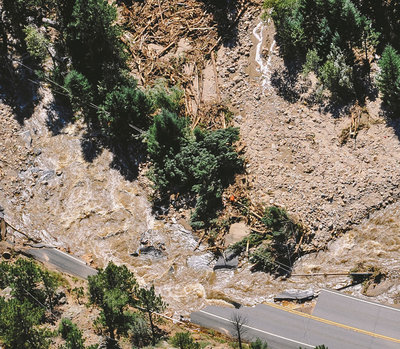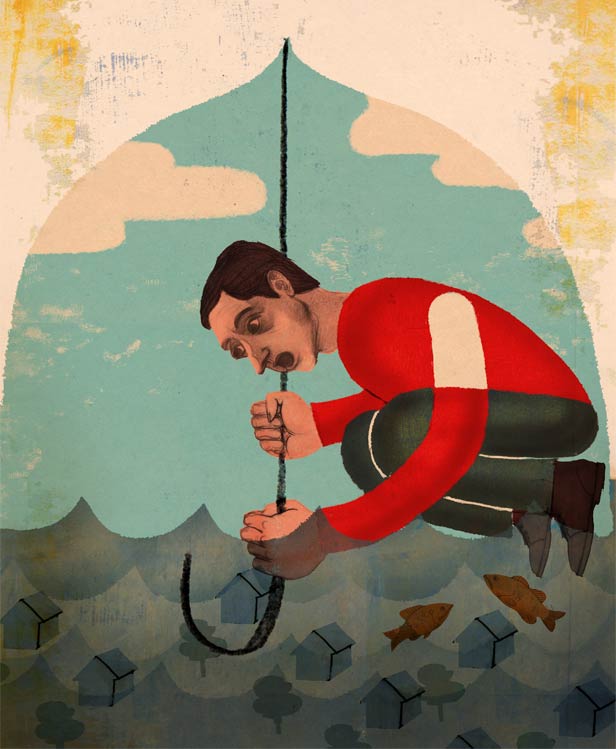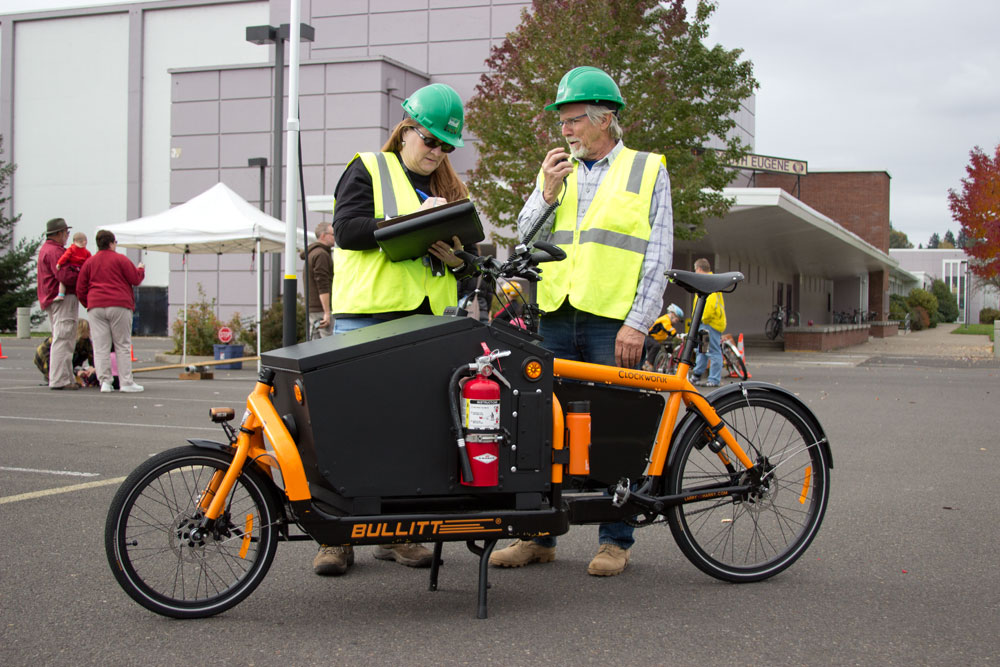
Nothing says death and destruction like climate change.
Actually, for most of us the effects of climate change seem like something that will happen in the distant future, a tragedy for our grandchildren but not us. If we are going to think about planetary annihilation and devastation, we focus on Sharknado-like scenarios of wild hurricanes and tsunamis. And here in Oregon we tend to not to think about catastrophic natural disasters at all — it seems like earthquakes, tsunamis and deadly floods happen to other people, in other places.
But scientists know that the Northwest is going to be the site of a huge earthquake, maybe tomorrow, maybe in 50 years, thanks to the nearby Cascadia Subduction Zone. And the 2011 quake in Japan showed us a tsunami also looms on our horizon. Scientists know that here in Oregon climate change means sea levels are rising and flooding will grow worse in some areas, as will soil erosion, while other areas will hurt for water. The changes won’t be as swift as a tsunami, but they will come.
Resilience is the keyword these days, along with adaptation, rather than sustainability as communities realize even with massive changes to our fossil fuel use, we still have to pay the climate change piper for our carbon emissions of the past. It’s less about mitigating climate change and more about being resilient to its effects.
Disaster preparedness experts in Oregon try to get homeowners and cities prepared for the looming threats of shaking earth and giant waves — to be more disaster resilient. But not only is it difficult to persuade the complacent that these things are coming, the experts in disasters aren’t always in communication with the climate scientists who also warn of looming change, albeit a more slow, insidious change. Many threats could be best approached by planning collaboratively for both climate change and disasters, and some of them could be lessened by decreasing our dependence on fossil fuels.
Think outside the fossil fuel box
The University of Oregon’s Oregon Partnership for Disaster Resilience provides natural hazard planning assistance to communities throughout Oregon and is trying to increase the collaboration between climate and disaster experts. Josh Bruce, the interim director of OPDR uses the example of an aging critical energy infrastructure (CEI) hub near Portland as demonstration of the need for conversation between planners.
A state report on Oregon’s earthquake risk says this CEI hub is built on shaky ground. The hub covers a six-mile stretch on the lower Willamette River between the south tip of Sauvie Island and the Fremont Bridge, and it is a fossil fuel nexus for the entire state.
The CEI hub houses all of Oregon’s major liquid fuel port terminals, liquid fuel transmission pipelines and transfer stations, natural gas transmission pipelines and a liquefied natural gas storage facility as well as high-voltage electric substations and transmission lines. Some of the facilities there have infrastructure that’s 100 years old, and parts of it are built on soils that will undergo liquefaction — when saturated sand softens and loses strength during the ground shaking of a strong earthquake. The report, whose lead author is Yumei Wang, a geotechnical engineer with the Oregon Department of Geology and Mineral Industries (DOGAMI), says that the “energy sector is not prepared for a catastrophic Cascadia earthquake.”
In other words, oil and gas pipelines will burst, power stations will go down and we will be left without gas for cars and power for homes and businesses. This will cost Oregonians millions of dollars and potentially thousands of lives.
Talk to the hazards people, Bruce says, and the reaction is, “It’s vulnerable and we need to fix it.”
But Bruce argues that we need to take the long view — a better strategy is to decommission the infrastructure, disperse it and wean ourselves off fossil fuels. He says the climate change questions are the ones that don’t get asked by natural hazards people.
“These two worlds are not mixing the way they need to,” says Matt McRae, a climate and energy analyst with the city of Eugene. He says Eugene is working to implement a pilot project that will tie the two together in a way that “allows us to ask these elephant in the room questions.” Eugene has begun an “all hazards vulnerability assessment” that will reflect vulnerabilities to climate change, rising energy prices and other natural hazards.

Climate is not the question
Climate change is here, it’s getting worse and it’s causing problems. While scientists may talk about climate change in terms of “projections,” it’s not because they question whether it’s happening, it’s because they are still understanding just how much change, when and where.
Philip Mote is the director of the Oregon Climate Change Research Institute in Corvallis, and he was one of the lead authors of the snow and ice section of the 2007 fourth assessment report by the Nobel Prize-winning Intergovernmental Panel on Climate Change. He says projected future temperatures could be an increase of only two degrees, if we start to change the way we use fossil fuels, or “eight and half degrees if we continue to burn fossil fuels pell-mell.”
Mote says, “It’s not too hard to understand that if the climate is warming — and we know that it is — that there are responses in things that we can measure.” He says 70 percent of the West’s water starts as snowmelt, and scientists are seeing peak spring snowmelt and runoff coming earlier, the amount of snow on the ground is decreasing and the periods of low water flows are showing even less water. “All these things can be linked to warming.”
Climate models show we will have drier summers, and Mote points out that a lot of agriculture in the Willamette Valley relies on rainfall, so this creates challenges for irrigation, and less water creates challenges for utilities that supply drinking water. Add into the mix the increased risk of wildfires in western Oregon and insect infestations in trees from the warming temperatures.
And while some places will be drier and less prone to flooding, others, like those along the mainstem of the Willamette River, will increase in flood risk during the warm winter storms, which not only bring rain but also melt snow.
Bruce points to the recent massive flooding in Colorado as an example of increasing risk in an era of climate change. “Fires came through and wiped out vegetation, and then you have these strong, outside-the-norm, rain events.” This exacerbates potential for flooding, Bruce says. And if Oregon faces more wildfires in summer followed by high precipitation in winter, we too could be seeing these outside-the-norm floods.
Looking to the coast, Mote says that global sea levels rose 8 or 9 inches in the 20th century. In the Northwest, the frequency of large waves has increased, though according to Mote, it’s not yet clear if that increase is linked to other changes.
What is clear is that the larger waves cause increased coastal erosion and the ocean is getting higher, which affects communities, facilities and homeowners along the coast who are at risk of sliding into the sea.
Disaster prepared
McRae says that the work of Josh Bruce and Mike Howard at the OPDR is on the front lines of bringing together the two worlds of adapting for climate change and preparing for disasters. Bruce says that in view of the Cascadia earthquake to come, as well as things like more severe climate change-induced storms and sea level rise, “a 72-hour disaster preparedness kit doesn’t cut it any more.” Government-recommended disaster preparedness kits contain food, water, medical supplies, flashlights, sanitation and other supplies to use in the event of a natural hazard cutting off power and transportation.
Bruce says instead of being out of water for days, imagine being out of water and power for weeks. “Thinking about personal preparedness becomes a lifestyle choice.” For example, having a cargo bike (see sidebar) becomes an element of disaster preparedness. “It’s not a bag you stock up anymore.”
He says that because Lane County’s natural disasters have been relatively minor — it’s rare that a storm leaves us without power for more than a few hours — it can be hard to get people to prepare for a dramatic disaster like an earthquake, let alone climate change.
Oregon may seem quiet when it comes to natural hazards, but the silence is deceptive. Bruce says he places natural hazards in two categories: First are those on a chronic, annual basis such as floods, wildfire, winter storms and windstorms. These chronic hazard events sometimes rise to the level of a disaster, he says.
Then there are catastrophic events. “The obvious one we are most concerned about is the Cascadia subduction earthquake and the subsequent tsunami event that will follow,” he says. Geological records show that the Cascadia Subduction Zone produces magnitude 8.0 earthquakes about once every 250 years and magnitude 9.0 every 500. The last mega-earthquake in Oregon happened in 1700, according to geological and historical records, and even Native American legends.
According to the DOGAMI report, the Cascadia earthquake could be as large as a magnitude 9.2, “which would shake a substantial portion of the Pacific Northwest and create a tsunami that would flood low-lying coastal areas.” The report says a magnitude 8.0 or higher quake “would likely result in thousands of fatalities and widespread, devastating damage throughout western Oregon.”
Bruce says not only does Oregon face tsunami damage the way Japan did, but also we are far less prepared for the earthquake damage because we have not had a history of quakes that take out old buildings and instill a culture of preparedness. “So much of our infrastructure is built so people will survive,” Howard adds, “but not so it will stay up.”
At the intersection of climate and disaster
In addition to fostering conversations between those who are modeling climate change and those who are predicting disaster, sometimes OPDR finds that conversations need to happen within a community itself. Bruce tells the story of how the city and Lane County had planned to use the UO’s Mac Court as a place to house citizens in an emergency, but they hadn’t checked as to where the school itself was planning to put its students in an emergency. That place also happened to be Mac Court. “There are a lot of assumptions that get made,” Bruce says.
McRae says that Eugene is more collaborative than most communities and is unique in that its “Community Climate and Energy Action Plan” takes into account climate, natural hazards and energy as it explores community resilience.
Coastal communities might have disaster experts coming in one day to talk about how to plan for inundation from tsunamis. Then another day climate change experts say as oceans continue to rise, coastal communities need to plan for the bigger waves and higher seas. If the natural disaster experts are in dialogue with the climate change experts than communities from the coast to the valley can put into place changes that help them to be resilient from both types of disasters, whether that’s by building higher up from the ocean or river or moving critical infrastructure like hospitals away from flood and tsunami zones.
While Lane County has seen high waters in the past, climate change means there will be a diversity of challenges, including something we are less prepared for — extreme heat in the summers. “All of these challenges are big challenges,” Bruce says, “and we need to break down our traditional styles of doing business. Multiple strategies are really important.”
In addition to the pipelines and fossil fuel infrastructure Oregon already has in place, the state has also been dealing with companies looking to export coal, liquefied natural gas and oil. This raises the potential of disasters in the near future — oil and coal spills into the Columbia River for example — but it also raises the question of long-term climate change related problems.
“From my perspective, those are really interesting and complex policy problems,” Bruce says, “dealing with job creation, exacerbating global warming and placing those port facilities at risk.” For example, port facilities are now up against sea level rise, larger waves and tsunamis and they need to prepare for those problems.
So you have a port facility whose fossil fuel export creates the climate change that causes the rising oceans. “Are those two things compatible? Is that successful adaptation?” Bruce asks. “I’m going to say hell no.”
For more on the work of the Oregon Partnership for Disaster Resilience go to csc.uoregon.edu/opdr and for Eugene’s climate and energy plan go to wkly.ws/1lc.

Biking Out of Disaster
When roads are blocked and gas is scarce, bikes can be a community’s best vehicles to bring relief to its residents and restore order. On Oct. 12, 34 riders at Eugene’s first-ever Cargo Bike Disaster Relief Trials (DRT) demonstrated some of the useful things cargo bikes can do.
Cargo bikes are built in many styles, and one visitor to the DRT even brought a bike with an operational ham radio built into the front. Another participant competed on a cargo skateboard. But event organizer Austin McKimmey says that long-tail cargo bikes — bikes with a longer rear rack and deck — are the most popular in Eugene. “If you try hard enough, you can strap anything on the back of the bike — kids, adults, groceries, lumber, surfboard,” he says. “Your average cargo bike will hold up to 400 pounds, including riders.”
Riders at the DRT followed a 20-mile course with checkpoints where supplies might be distributed after a disaster, and the challenges included carrying bikes over barriers, passing through 6 inches of water, traveling through rough terrain, transporting both heavy and delicate cargo, covering distance and navigating with only a paper map. Lucas Strain from the Cascade Courier Collective team won the race in 1:37 hours on a front-loading Long Haul built at the Center for Appropriate Transport in Eugene.
Jason York, the city of Eugene’s emergency program manager, says the event showed that cargo bikes can be used for transport, spreading information and damage assessment. “There’s a ton of things that we can use them for, and I’m looking forward to sitting down and putting that on paper and to figure out how we can actually make it official and roll them more into our planning process,” he says.
The biggest post-disaster advantage to cargo bikes, York says, is that they don’t require a fuel source. “They’re far more versatile and flexible,” he says. “They don’t have to necessarily follow the roadways, and that just gives us an additional tool that’s flexible in disaster response.”
— Words and photo by Shannon Finnell